-
Posts
19,756 -
Joined
Content Type
Forums
Detector Prospector Home
Detector Database
Downloads
Posts posted by Steve Herschbach
-
-
They sure missed a bet not having this out a month ago. Would have been on a lot of Christmas request lists!
Got no idea but would not surprise me if it is the same price as an Ace 150 metal detector. They have to be making a mint on these pinpointers.
-
Lots of machines still doing the notch thing but it has fallen out of favor with a lot of the people that have been around for some time because it boils down to "what is safe to notch out". Really, almost nothing.
If you are a coin cherry picker you can just set up for coins and notch out the "trash" but except for recent drops that gets you next to nothing in most hard hit places these days. In a way people are just getting more and more determined to find the few old coins that are left and that means getting closer and closer to darn near just digging everything.
I know exactly what you mean Ray. I was running the F75 with 5" coil against the Nokta with same in the park. I could care less what I was finding, my goal was simply to find non-ferrous targets in a place I have hunted quite a bit before. What I see and I am sure you see are ferrous targets that a guy just swinging along would pass right over. But when I get that target, I work it, and it may read ferrous on five swings and non-ferrous on two. Or maybe just a squeak. There is a lot of small foil that wants to read ferrous but also items as large as pull tabs down only 3 - 4 inches that are trying to read ferrous. All I am doing is going home with a pocket of aluminum but I am honestly having a ball. I just love running detectors.
From a nugget hunting perspective those are all gold nuggets that are trying hard to disguise themselves as ferrous targets, so I enjoy making them reveal themselves. The Nokta in my very limited experience so far does seem to do it in this crazy no-brainer fashion. Just turn on, ground balance, go beep. The DI2 mode defaults as she boots up really work well. Frankly, that suits me lots more than menus and a zillion tuning choices. My SDC must be getting to me!
Today was going to be Nokta versus V3i at 22.5 kHz but got rained out.
-
 1
1
-
-
-
On 12/23/2014 at 9:33 AM, cobill said:
This is just the kind of discussion I was interested in and many of my questions have been answered. I really appreciate Steve's insight and knowledge of iron volume, V-break, "to dig or not to dig" thoughts, etc. Most of us just do what the detector tells us to do...it's just not that simple! So we just keep buying the latest and greatest detector as a magic bullet to calm down our gold fever. I'm going to "nominate" Steve as our detector tester/reviewer and make purchasing decisions based on his detailed analysis. Do I hear a second?
Bill
Hi Bill,
Well, I would use extreme caution in that! The bottom line is I love playing with detectors and I am more than happy to share what I know or pass on my thoughts in hopes that it will help others. It gets more mileage out of the effort. But I do make decisions for purely personal reasons that may not jive with others.
The machines are very, very competitive these days. It is like buying a PC - there are many that all do the job just as well. I therefore am looking at other things also.
Look and feel. I like the T2/F75 both in look and feel. I like the simplicity of the control set and yet the depth of the feature set. It had issues for urban use but the upgrades appear to be addressing that. It uses AA batteries and I am trying to stick with stuff that use AA batteries. So I am disinclined towards the Gold Bug Pro for no other reason than that it uses a 9V battery. The DEUS with three separate rechargeable items? No thanks!
I like detectors that have a 5" or smaller coil available and a 15" or larger coil available. Again, loss for DEUS, and $400 coils are a turn off anyway.
But should YOU avoid the Gold Bug Pro just because it uses a 9V? That would be silly. Or the DEUS because it is rechargeable and wireless? Most people think of that as being a huge plus. I am the odd guy out there.
No, just take me as a data point to be averaged out with the opinions of others who have been around awhile.
-
 1
1
-
-
Merton, you are sharper than you let on when it comes to detectors! I never have issues with anyone seeking knowledge. I wish I had great answers for you but after 40 years of detecting I still worry the same old problems around in my head and chase my tail trying to find perfect machines. I have exactly your same issue with the Gold Bug Pro and just sold mine. I want more options. I am hoping the F75 is going to do it for me. The Nokta actually works great, but again, limited options. I am eyeballing the F19 but to show you how I can be about things I just do not want camo so I am waiting for the new Teknetics version of the same machine, an improved G2. I am trying to stay with AA detectors so again prefer the F75 to win out over the F19 but in the end performance will tend to sway me. Maybe. I value lots of things in a detector and the fact is I am going to have to compromise somewhere and I just can't say yet what will win me over. I really like the F75 on my arm so it is its game to lose.
I am hard on the same quest as you. I am doing it purely for my own purposes but if I pass along my findings it may help you or others. I have to say though there is a reason I ultimately bite the bullet and get the detectors and do it myself. I read all the forums also trying to glean information but in the end to get the answers I want IN MY GROUND I have to try it myself. I could swear the Nokta is sliced bread working for me, and you get it and put it on your ground and it sucks. That is why I try to be careful to not get pinned down with absolutes because in detecting I can't seem to find any.
True story about the Nokta is I am trying not to like it! I don't really like the overall physical layout and would just as soon toss it and use the F75. The problem is I am taking the "not upgraded" F75 and Nokta out and the Nokta simply runs cleaner for me. It is pulling up non-ferrous targets better than this F75 - so far. I have an upgraded version on the way slow boat going the wrong way around the world but sooner or later I will get it. And if I have to the F19 or new G2. A new MX version if one appears. Eventually I am going to beat this down to one unit but it is going to cost me some bucks to sort it out and I am ok with that. All I can say about the DEUS is good luck with that. Absolutely great detector but just not my style. I will very much appreciate any new thoughts you get about it as you use it in return for all the typing I am doing here!
-
 1
1
-
-
Ground and hot rock elimination is just another type of discrimination with all the same problems of target overlap. There is no doubt we are seeing vast improvements in battery technology and microprocessor based signal analyses that is narrowing the range over time. We have come a long way since 1970 in metal detectors and we are not done yet. Seems like we got a whole new crop of bright minds looking at the problems in recent years and that is sure to lead to some advances.
-
 1
1
-
-
OK, lets flip this around. Lets say you have a Fisher F75 or AT Gold or X-Terra 705 where the tone break is preset. Is all lost?
Not at all! You just end up with three basic zones. In the case of the Garrett AT Gold above, you set the ferrous reject point at 30. Everything under 30 is simply rejected, and you get to pick exactly where that rejection point occurs. The low tone from 30 -39 would be treated as a ferrous/non-ferrous overlap tone so when you hear it you know it is probably ferrous but may be gold. The idea is just like in the case of setting low tones conservative and digging them because they might be gold - do the same here. The 40 - 50 range is going to be called non-ferrous by Garrett but it could also be a ferrous target.
My F75 automatically splits tones at 15 but anything from 1 - 15 could be gold also even though it is more likely to be ferrous. I can still just like the Garrett set a kill point for the low tone to go silent. For instance, I can set the discrimination at 0 so everything 1-15 has a low tone that I would dig.
The point being that this idea of V-Break or having a variable break point for the tones is nice but it is not that big a deal really. It allows you to have a set tone that says "Dig" and a tone that says "Don't dig unless you feel like it". Very easy to mentally process. But when you think about it you get nearly the same thing with a factory preset. Maybe the break point is not exactly where you want, but if you are being conservative it really does not matter. In either case you will dig a lot of low tones, most will be ferrous, but a few will be gold.
What I think is most important is far more basic. Which machines just make the right call more often? I really want to just dig gold and not dig nails, so which machine will give me the most accurate answers as to which is which? Sadly, like all things in detector land, it appears to depend on the ground itself more than anything, and so what works well in one location can not be depended on to work exactly as well someplace else. And that is why the debate never ends on the internet as people compare notes from all over and find they get different results in different areas with different machines. There are no cut and dried solutions. If there were, everyone would own the same detector.
Still, some detectors are better than others. The goal in the past has been to eliminate junk, and so detectors were more aggressive in rejecting junk targets. The problem is good finds got missed. Newer detectors are sliding the scale to be less aggressive in rejecting junk and so more good finds are being made. The dirty little secret nobody likes to talk about is more junk is also getting dug as a consequence. New people buying these latest greatest detectors for pulling goodies out of the junk are getting a big surprise when they are discovering they are going to dig lots of junk targets also.
-
 1
1
-
 1
1
-
-
For those new to this here is what we are talking about. I am going to use the Garrett AT Pro visual display here as an example:
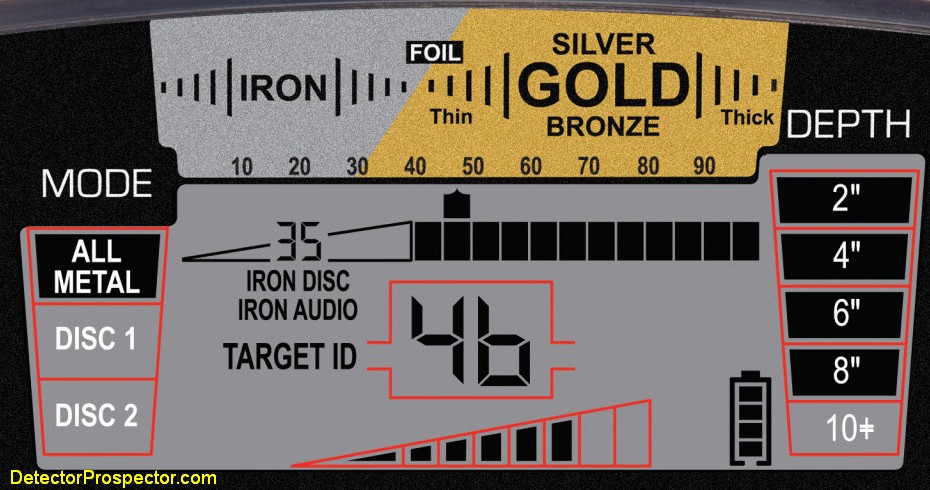
The graphic on top illustrates the Garrett 0 - 100 range of possible target identification numbers. White's called these Visual Display Indicators or VDI numbers and so you hear them called that a lot. Note that ferrous targets fall on the left and non-ferrous on the right. Ferrous items because they have magnetic properties are unique as opposed to non-ferrous items which are not magnetic, allowing for this basic separation of metal types. They also usually have a low conductivity and non-ferrous items a higher conductivity, but some ferrous items are very conductive and so will trick these systems and read way up in the non-ferrous range. Items with hole like washers and nuts are big offenders along with flat steel plate materials, including bottle caps.
Notice that 30 and lower would generally be considered ferrous, and 50 and above non-ferrous. The range from 30 to 50 overlaps ferrous and non-ferrous. This is quite a spread! That range is the entire problem because there is no clean break between ferrous and non-ferrous. A numeric reading of 42 could be a small flat flake of steel, a small gold nugget, a piece of aluminum foil, or a bit of lead.
Garrett has rather predictably chosen 40, right in the middle, as their preset location for the machine to make basic ferrous and non-ferrous decisions. The LCD area below the graphic has blocks in the non-ferrous range and a separately adjustable ferrous range from 39 on down to zero. The example shown has 35 set, which means 35 and lower will not sound off at all. 36 to 39 will make a ferrous low tone. 40 and above higher non-ferrous tones depending on the scheme chosen.
In theory you can monitor the VDI numbers and if you get a low tone reading of 38 decide to dig it anyway. The main issue brought up in this thread however is that Garrett has chosen 39 as the place where tones flip from ferrous to non-ferrous and you can't change that. That means the range from 30 - 39 is always at particular risk of being ignored. The Garrett solution would be to set the ferrous discrimination point at 30. that way 30 -49 would give a low tone but you would know that might mean ferrous and it might mean gold.
Instead of 39, would it not be nice to just set your own point anywhere from 30 to 50 for the tone to break? You would then go strictly by the tone, never referring to the display. The choice would depend on your mood and how aggressive you want to be. Set for 30 and you will dig more ferrous stuff but but have less chance of missing gold. At 50 you will dig almost no ferrous stuff but also miss some gold.
Fisher has this feature in the Gold Bug Pro and other models and they have called it V-Break, for Variable Tone Break. You just turn the knob and decide at which point you want the tone to flip from ferrous to non-ferrous. The new F19 also lets you adjust the tones themselves and the volume of the tones. The DEUS and a few other models offer the same ability. White's has had it since day one on the MXT - this is not a new feature.
Finally, I should mention some people just do not want to hear it. Traditional discrimination systems have always had the ability to set the ferrous/non-ferrous break point, but it was so that anything below the break point is totally eliminated from signalling. You do not listen to constant ferrous tones and just dig anything that beeps. This actually can work and you can hunt like this and find gold. The Gold Bug 2 has the simplest system of all. Just flip a switch, and all ferrous signals below what would be the Garrett 30 mark are eliminated. It is conservative, simple, and works. I have dug thousands of nuggets using a Gold Bug 2 in disc mode. The theory again is that I also missed a lot of gold and no doubt did, but as I said in the earlier post, it is about what you go home with, and I do pretty well.
I want to emphasize that I do not believe there are specific right ways or wrong ways of going about all this discrimination stuff. The only sure thing is to dig all targets, but there are all sorts of reasons people may not want to do that. Mine is usually a time thing. If I only have an hour I am going to cherry pick. The more time I have, the more digging everything makes sense. The type of discrimination system a person employs is very much a personal choice. I am keenly aware that many people just hate digging junk and so if using discrimination makes for a more pleasant experience, that is a good thing. Seriously, for most people this is a hobby, and a hobby should be fun. I would rather a person enjoy themselves and stick with it than just give up in frustration.
The goal here is just to inform so that you understand the choices you are making and the possible consequences. Everyone who uses discrimination eventually will have somebody come right behind them and dig a target they passed up, and have it be a nice gold nugget. Use it when you feel you must, but try to not become reliant on it as eventually it could cause you regret.
See also Metal Detector Discrimination Really Sucks and Metal Detectors With Reliable Target ID Numbers plus Tune Out Nails, You Will Miss Gold-
 1
1
-
 1
1
-
-
Well, in general I tell visitors to shoot for June. Most places are thawed out by then and the weather is about as good as it gets. Generally the later in the year the worse the weather. We are talking weather though so you just never know.
Ganes Creek is no longer open to the public. The best options as similar regard pay-to-mine detecting places are AkAu in Nome and Paradise Valley in the Brooks Range.
For those driving I do think Chicken is a great option having done just that myself the last two summers. Easy for a first time visitor and tons of tips on this website.
For information on these and other paces you can go in Alaska see my Public Mining Sites in Alaska page. For more about Chicken see Steve's 2014 Alaska Gold Adventure
If money was no object probably my first choice for me personally at the moment would be AkAu in Nome just because I have only been to Nome a couple days and never spent any time prospecting there. However, it is a fly to Nome thing and so not a cheap date.
-
And Best Wishes in Return to Everyone at Nokta and Makro!
I was fascinated to find out this morning that Santa Claus was born in Turkey. From http://en.m.wikipedia.org/wiki/Saint_Nicholas
"Saint Nicholas (Greek: Ἅγιος Νικόλαος, Hagios Nikólaos, Latin: Sanctus Nicolaus); (15 March 270 – 6 December 343),[3][4] also called Nikolaos of Myra, was a historic 4th-century Christian saint and Greek[5] Bishop of Myra (Demre, part of modern-day Turkey)."
I like the look of the detector that Santa Claus is holding. Maybe something in the New Year to be happy about?
Merry Christmas and my best wishes for good health in the New Year to all my forum visitors and their families!!
-
I prefer to hunt dual tone when using audio discrimination for a ferrous/non-ferrous decision. That feature should be adjustable for the reasons you have described. Off the top of my head:
Fisher Gold Bug
Fisher Gold Bug Pro
Fisher F19
Minelab CTX 3030
Teknetics G2
White's MXT versions (not MX5)
White's V3i
XP DEUS
There are more of course but these are the more familiar. You have two at least that are on the list so you are set.A nice feature I am craving is the ability to adjust the volume of the ferrous response, also called iron volume. Not the overall volume, just the ferrous. This is nice because in heavy trash there is a barrage of ferrous noise and turning it down while still having a loud non-ferrous response would be nice. The DEUS allows for this as does the Fisher F19
Two models I have that do not have the adjustable break are the non-upgraded F75 and the Nokta. Of the two the Nokta has the better preset tone break. The FA Mode of the upgraded F75 addresses that somewhat plus adds iron volume, but in either case you are stuck with what the factory has decided is best for the ferrous break point. Not the optimum solution but then again it can work.No matter what machine you use there has to be a point you choose where the target VDI tips between ferrous and non-ferrous. No matter where that may be, and especially on factory preset models, you always want to try and put the signal in context, and if you are ever suspicious, investigate further. This is why I prefer to hear a ferrous signal as opposed to just having ferrous signals totally blanked out. You know they are there and can maybe decide you want to dig it anyway. If the detector never alerts you to the target in the first place that opportunity is missed. With factory preset models you may simply have to know to investigate more often. Investigate can mean nothing more than a quick scrape of the surface to double check before moving on.
To answer your question in the post though - yes, we are always missing nuggets. It is not about what you miss however, it is about what you take home. The real question is "what method maximizes your investment of time for the best return possible in that time?" If there are 500 trash targets and one decent nugget, digging every target may not be the best answer to that question. If that nugget is under a nail, digging every target may be your only answer.-
 2
2
-
-
Hi JP,
Just a kid playing with toys still, that's me.
The 705 has an awesome VLF all metal mode. But switch to Coin Mode to get a dual tone ferrous/non-ferrous response and the machine goes all kinds of gutless on me. I actually really like the 705 as an all around machine but let my last one go a year ago. Like always though wish I still had one to fuss with. Nenad tells me I need to trust Iron Mask in Prospect Mode more, but then says Iron Mask on the Eureka works better yet.
The MXT is just good, really good. Chris has one and I think I will borrow it to bump heads with the F75 and Nokta. I really have never found anything yet that clearly works better than an MXT but ditched mine for the F75 due to the F75 weighing less. But I am seeing some things on the F75 response to extreme low conductors that bothers me, though the new F75 update addresses that very issue so I need to get my hands on one. Latest word is I will have one on the way after the 1st.
Crazy true story today I was out with the Nokta and F75 trying to make myself not like the Nokta so I could ditch it for the F75 but the darn thing just works real well in my ground. The physical layout of the machine leaves a bit to be desired but fact is just turn it on and go, and it does very well.
The main problem we have JP is that it is almost a sure bet what works best in my milder ground is not going to work very well in your horrible ground. It is aphard enough just to get a VLF to work at all in Australia in all metal mode. Getting a detector to somehow identify gold accurately when the ground itself is iron ore is near impossible. I think less hot, lower frequency or multi-frequency will handle the ground batter, and you have to just resign yourself to finding the bigger nuggets in the midst of the trash. But find one nugget, and that is the place to put PI coil on ground and work out from.
Ask Bruce why he can't make an extremely high power multi-frequency detector that gives us better depth in bad ground than the CTX seems able to deliver. The answer always seems to be that putting all the punch into a single frequency gets better results. Why not just boost the punch across the board in all frequencies?
Yeah, I know. Layman asking silly questions that make no sense to people who really understand how things work!
-
There is no one clearly superior VLF or this whole thread would have no purpose. They all are very good or all just as bad, depending how you want to look at it. In Alaska the White's MXT was the go-to machine but any good mid-frequency VLF can do the job. My preference is for a dual tone arrangement, low tone ferrous and high tone non-ferrous, which is just what you get with the MXT Relic Mode. See http://www.detectorprospector.com/gold-prospecting-equipment/whites-electronics-mxt-metal-detector.htm for MXT tips.
A US nickel is equivalent to about a 1/4 oz nugget, so as long as you are comfortable rejecting all nuggets under 1/4 oz that might work. Honestly, that is a coin hunter setting, not a nugget setting. For nuggets, you want the absolute bare minimum ferrous rejection possible, or about enough to tune out a small nail.
That will eliminate most ferrous junk but certainly not all. Steel bolt or large spikes, large washers and nuts, steel plate, etc will still sound good. A VLF can greatly reduce the amount of junk you will dig compared to a PI but you will not eliminate all ferrous targets without eliminating nearly all the gold also.
It actually just depends on the location. Some places you just have small ferrous stuff that is easy to deal with. Other places are full of big stuff, and that is a problem no matter what.
-
The nearest I will ever get to HF is the Whink 1% solution. I may take a month to do what the high power stuff will do overnight, but they do sell it in grocery stores because it is safe - by comparison. Thanks Steve, you did a good job convincing me that HF is best left to professionals. I will hire one if it needs using.
-
Moving along, here is an update. I added a photo in the original post with exact weights and dimensions of all large coils with an extra note in the test on dimensions. Here is a shot of the four small coils and all four detectors with small coils set up. Weights of detectors as pictured with small coils:
Fisher F75 with 5" round DD coil 3 lbs 4.6 oz
Nokta FORS Gold with 4.7" x 5.2" DD coil 3 lbs 15.0 oz
White's V3i with 4" x 6" DD coil 4 lbs 0.4 oz
Minelab CTX 3030 with 6" round DD coil 4 lbs 12.2 oz
-
 1
1
-
-
That is so cool. Both things I thought needed doing, and Nokta did it. Now of course there will be people who own the previous versions who will complain. I will not be one of them - I love this kind of responsiveness from a company. What do we want - we want companies that listen and give us what we want! I don't care what it costs if it does what I want.
Ultimately what I want is a FORS model with a forward facing control panel as is somewhat standard in the industry. Keep the batteries and circuits under arm for balance but I would like to be able to see that nice LCD readout that is tucked up against my leg and be able to reach those buttons without turning the detector on its side. I will be first in line to buy the next full blown remake of the FORS CoRe.
Anyway, good move with the new switches and Happy New Year to everyone at Nokta and Makro!
-
Good question!
I have accumulated too many detectors in the last couple years, and have some old ones I never use anymore, so time to clean house. Part of the problem is when I get down to the last few I like them all. To narrow it down I have to use them, and the FORS Gold I have not used much compared to my other "keepers". I was using it precisely because I am still learning with it.
The two or three that are really bugging me are the F75, Nokta, and one I have never used, the F19. Having used the Gold Bug Pro though I have a good idea what the F19 is like. The F75 has a big edge in that I prefer its ergonomics over any other detector I have ever used. I am looking for a unit to sort ferrous from non-ferrous as efficiently as possible, yet still cover certain practical check marks that mean a lot to me. I could go on for hours about the ins and outs of these few detectors as they matter to me.
The lesson here is I use what I use not for sheer performance always but because of things like how the detector feels, how it sounds, what batteries it uses, and how robust it is physically. How many coils are available for it? Frankly, the top end detectors all perform so closely I can use any of them and do well, so it is the sum of other factors that often tilt my decision one way or the other.
Another machine that would get my interest is one that does not even exist. If Whites stuffed a full fledged MXT in the MX5 box, especially if it had manual ground balance, it would perk me up. I love the MXT but want it slimmed down. Which in many ways is what you get in the F75.
I do a huge amount of detecting that never hits the forums of course, much of it at a nearby park I favor. Right now I am hauling detectors there in pairs and alternately finding a target with one, checking with the other, recover, then switch. It is very hard with stock coils to find anything with the Nokta that the F75 can't find and vice versa. Suffice it to say I will be wringing the best out of these detectors for some time to come. I had to remind myself I have no gun to my head making me get rid of either. It will sort out eventually.
Personal preferences count for much so you always have to be careful relying at all on what you read on the Internet. To cruise the forums you would think the DEUS obsoletes all other detectors. And a very fine detector it is. The only problem for me is it just does not float my boat. I prefer AA batteries and I like more coils than I can get for a DEUS. Yeah, it's a great detector, but I think there are lots of great detectors. Detectors are only third on my success list:
1. Location. Being on good ground for whatever I am after is paramount. Job 1. Everything else pales by comparison.
2. Hard work. Many hours of giving it the best I've got. The only way I know to find a lot detecting is to detect a lot. I spend a huge amount of time detecting nobody hears about. It may look like I am going out and making finds every time I go out - far from it.
3. Decent detector. Have a machine reasonably capable of the task at hand and know how to use it.
The more attention I pay to 1 and 2 the less important 3 is. If I really was inclined to do so I could probably make a Garrett Ace 250 look pretty darn good as a nugget detector. I would just have to work harder at it. Hard work makes up for detector deficiencies. The bottom line is I am finding the gold, not the detector. It is just the tool I am using.
Hopefully my passing on my thoughts and ideas about detectors helps people but to use any detector just because it is what I use no more guarantees success than my using the same golf clubs Tiger Woods uses will make me a great golfer. People ignore the fundamentals because it is easier to think just having the right detector will make the difference.
Obviously I have a bit of time on my hands at the moment so you got me in a blabbing mood! The last thought here is that I am passionate about detecting on a whole different level. I just like the machines, like trying them out, like learning about them, like trying to learn what they do best. They almost all shine in some way if I can just figure it out, and then use that to my advantage. It is my idea of fun, a good time. I could just get a good machine and always use that one, and be better served by getting to be a true expert with it. I am like a jack of all detectors but a true master of none. But for me, using the same machine all the time would be no fun.
And that is why I was using the FORS Gold!
-
 1
1
-
-
I am not a huge fan of air tests as relating to real world performance but they can be instructive. They may not reveal what a detector can do in the ground per se, but they can eliminate certain possibilities. If an item cannot be detected in an air test, the chances of hitting it in the ground are nil.
I set up the Fisher F75 SE with the 5" round DD coil. The Minelab CTX 3030 with the 6" round DD coil. The Nokta FORS Gold with the 4.7" x 5.2" DD coil. And the White's V3i with the 4" x 6" DD coil. Close as I could get them all to each other.
I then subjected them to my Bic Ballpoint Test. For many years in a retail environment I have found the perfect small test item to be a cheap Bic pen with an all plastic barrel, and brass tip with 1mm tungsten carbide ball. A "med/moy" or "medium" point. The plastic barrel serves to keep your hand from affecting hot machines like a Gold Bug 2 or GMT. Papermate has an equivalent all plastic pen with a small brass tip.
In a nutshell, if a detector can't hit the ballpoint, it is not going to do well as a small nugget detector. Most coin detectors you can sign your name on the coil and get no signal. Nearly all VLF detectors sold expressly for nugget detecting pass this simple test.
Why not use a small gold nugget? The problem there is if you want to do tests and put them on the Internet, use something nearly everyone can acquire and use to repeat the test. Otherwise you always have an out when results differ. Anyone should be able to do what I do and get the same results. If not, then we have uncovered a case where two examples of the same detector differ in performance, which in itself teaches us something about the brand. The Bic does a fine job of representing a small non-ferrous target. In case you were wondering, tungsten carbide reads low conductive just like gold, so that is not messing with the signal.
My other standardized test item is the US nickel which does a fine job of mimicking a roughly 1/4 oz gold nugget.
The initial result? In all metal, the F75, Nokta, and V3i all easily hit the ballpoint. The CTX? No signal.
Where it got interesting was in the discrimination results. Specifically as in setting up for dual tone ferrous/non-ferrous responses. The Nokta in basic boot up DI2 dual tone mode gave a clean non-ferrous tone and VDI reading of 44. The tones split at 40 with lower numbers ferrous and higher numbers non-ferrous, so a good solid non-ferrous indication.
The V3i in 22.5 kHz mode gave it a solid VDI of 2. The White's splits at zero with positive being non-ferrous and negative numbers ferrous. Good clean hit. Better yet, when turning off VDI normalization it kicked the native 22.5 kHz VDI up to 10 which is really good.
The F75 SE? A solid VDI of 1. The problem is about 12 and lower would normally be ferrous. Many people will drop the setting to 6 knowing the F75 will call smaller non-ferrous targets as ferrous. Unfortunately in this case it drops it right down to the low end of the ferrous readings, guaranteeing a low tone ferrous response. This is an "not upgraded" F75 and I am anxious to see if the new FA mode brings the VDI up on this test item.
My primary goal here is bigger gold using bigger coils, but the more capability packed into one unit the better. It is no secret the 19 kHz Gold Bug Pro will identify small non-ferrous better than the 13 kHz F75 so no huge surprise here but I can't help but be disappointed. The F75 all metal audio response is just fine but if I want to dig everything I will use a PI. Not any surprise about the CTX either since multi-frequency is not known for being hot on small gold. The V3i ability to run single frequencies gives it a clear edge here. In ground tests often even things up or stand them on their head but for this real basic round one, the win goes to Nokta and V3i.
-
 3
3
-
-
I can promise you looking at the controller above I will not be piloting one anytime soon! Awesome looking rig AzViper.
-
Things that work don't always need explanations. They just need to work. There are lots of theories for what you are experiencing though. It sounds to me like the ability is something innate in you and not imparted by the equipment per se. Are devices that cost a lot of money better than bent robs or something else that can be fashioned at home?
-
Minelab alone did $166 million worldwide in 2013, which we know because the parent Codan is publicly traded. Most everyone else is private so harder to put a number on, plus Minelab enjoyed a spike in 2013 due to the gold rush. It is not a huge market per se, but I am guessing a half billion a year worldwide would be conservative. And innovation is not that hard to do - just look at XP. They just took obvious ideas people have been requesting for years and applied them. Wow, wireless, what a concept! More depth is hard to do, but lighter weight, better balanced detectors with color displays, wireless communications, and Internet upgradeability are all low hanging fruit the U.S. manufacturers seem reluctant to pick.
-
 1
1
-
-
Hi Greg,
Yeah, I am for sure not trying to sell anyone on the V3i. In fact, just the opposite. Most people should stay away from it unless they really know what they are getting into. Massive feature overkill.
I highly recommend the mid-frequency do-it-all machines for jewelry detecting. The MXT is the default choice for anyone wanting power and simplicity in a detector.
In theory you could use the GMT and for tot lots or other easy digging sandy areas it actually is a good choice. But like the Gold Bug 2 the extreme sensitivity plays against it in the turf. Just too much tiny aluminum to contend with.
It appears we temporarily lost Mike, not just here but on the other forums. Hope he is OK. Mike and I have kind of shadowed each other with parallel thought processes on detectors over the years. One of those two people independently coming to similar conclusions kind of things, so I have always paid attention to his posts.
-
Long Range Locators (LRLs) are a belief system. You either believe in them or you do not. Since there is no proven science behind them the believers are unable to prove they work. And since you can't prove a negative the skeptics are unable to prove they do not work.
The believers http://www.treasurenet.com/forums/long-range-locators/
The skeptics http://www.geotech1.com/cgi-bin/pages/common/index.pl?page=lrl&file=main.dat including, for your enjoyment, a report on an early Electroscope at http://www.geotech1.com/cgi-bin/pages/common/index.pl?page=lrl&file=reports/escope20/index.dat
I am a "hey, whatever floats your boat" kind of person. I also consider myself to be a rather practical sort of fellow, so from my earliest prospecting days my methodology has been to seek out successful people and learn from them. I look at what successful Australian prospectors are using for instance. Practical people delivering repeatable results. For some reason most of them are using Minelab metal detectors. LRLs are not really on their radar. And that, in a nutshell, is all I need to know.
Because this subject has been known to go off the rails on other forums I will remind everyone that the keystone of my forum is respect for others. My expression of my opinion does not mean I am trashing your opinion. The world would be a better place if people would just agree to disagree rather than be dead set in convincing others their opinions are the only valid ones.
-
 1
1
-
-
When it comes to gold prospecting AND jewelry detecting in parks or other grassy locations, the multi-purpose detectors are generally the way to go. You do want to be able to reject ferrous targets and you may not want to dig every tiny little piece of foil ever dropped.
Fisher Gold Bug/Gold Bug Pro, Garrett AT Gold, Nokta CoRe/Gold, Minelab X-Terra 705, Teknetics G2, Tesoro Lobo, and White's MXT variants are major contenders for people that may already own them for nugget detecting
Being a niche detector guy my personal favorites have been the White's DFX now replaced by the White's V3i.
The secret to jewelry detecting is picking the right sites. The detecting can be as simple as set for bare ferrous rejection and dig everything else. Or you can try and get sneaky digging certain VDI numbers and ranges to try and improve the jewelry to trash ratio. Not everyone wants to dig every bit of trash in the park, and the fact is VDI targeting can be fun in its own right.
The two far opposite extremes would be a Tesoro Compadre for $160 and a single knob. It can do just fine. Set it to reject ferrous or maybe smallish foil and go to town digging everything that beeps.
The White's V3i is on the other end of the spectrum. Here is an example of just one of many possible display screens analyzing a target in three separate frequencies.
I think detecting should be fun, and part of the fun is trying different strategies and finding what works best for you. The key is to keep it enjoyable so you keep at it. If you keep at it, you will find stuff. It really is that simple.
-
 1
1
-


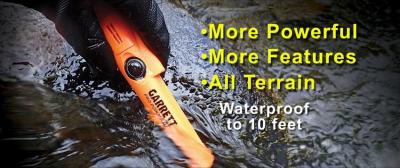
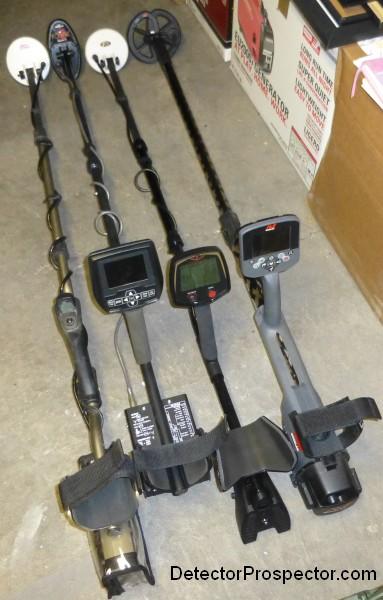
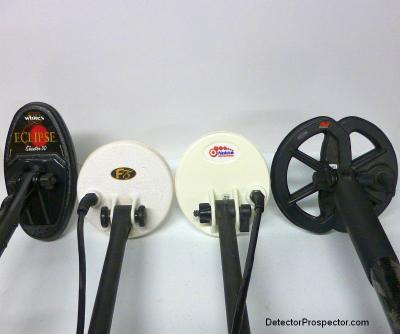
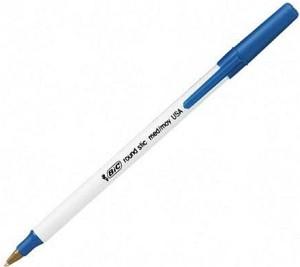
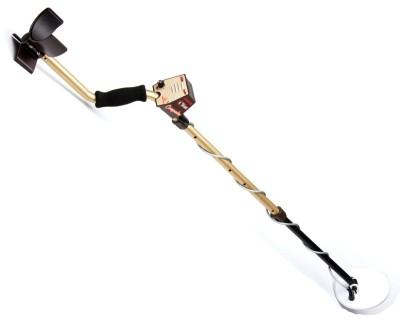
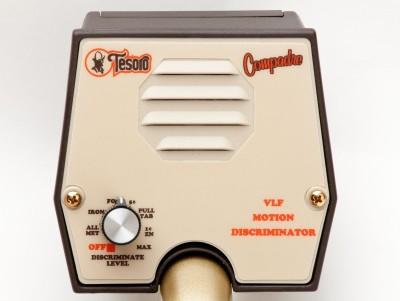
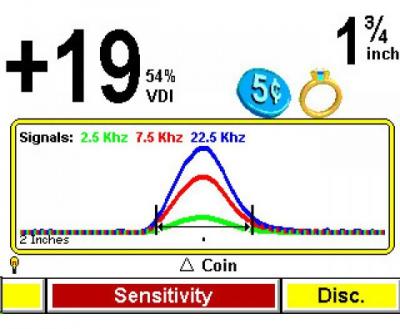
Holiday Wishes
in Nokta / Makro Metal Detectors
Posted
It is actually real? I think I can honestly say I am stunned. Being who I am I of course studied the detector in the holiday card above with great interest. That design configuration, if it simply equals the FORS in performance, could be everything I would wish for in a VLF metal detector. It may be an understatement to say that I believe the Nokta/Makro partnership has the ability to seriously disrupt the U.S. detector market in 2015. In a good way. This is an amazing development.
I am considering the way and the incredible speed with which some simple user suggestions have been implemented. What I see as a genuine desire to provide superb product support. And frankly Dilek, the way in which you personally comport yourself and communicate openly is perhaps one of the greatest assets that the company has at this time. Your professional responses are a breath of fresh air. As a very committed long term user of metal detectors I think I speak for many in saying we have been craving this kind of attention from manufacturers. If all of this is a sign of how the company is going to handle itself going forward, well, all I can say is if I could I would purchase stock in a company like that.
It is a very exciting development, and 2015 is shaping up to be an incredible New Year! Again, best wishes Dilek to you and your team!